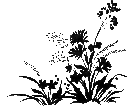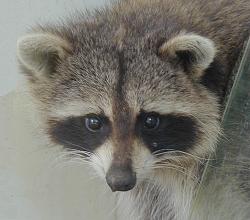 |
The Preserve |
News and Events |
Natural History |
The Trail |
Monitoring |
Restoration |
Library |
Organization |
|
Todmorden Mills Wildflower Preserve
|
Nature NotesYour nature guide for the week July 12-July 18Mammals
Young Raccoons are venturing out into the Preserve after being confined to their tree dens since their birth in late March. You may see them at dusk as they head out to feed, or find their tracks, with tell-tale long fingers, in the mud around the pond. The young animals have been weaned, but remain with Mum in family groups until winter. The big Crack Willows at Todmorden provide ideal den sites for raccoons and there is likely to be at least five families in the Preserve. The Toronto population has been variously estimated at between 16,000-40,000 animals. Trees and ShrubsIn the meadow above the parking lot some of the Staghorn Sumac clumps are sporting fresh bright-red fruit. The fruit won't be ripe until late summer and it usually persists through winter; it is only eaten by birds as a last resort. Clumps grow by suckering from the roots, and they can get so dense that they create deep shade. This is turn inhibits grass growth and provides good nursery conditions for tree seedlings. In this way, Sumac clumps may speed up the forest regeneration of old fields and meadows. The berries of the Red-osier Dogwood, a native shrub, have ripened to cream-colour and are providing food for the new crop of young Robins and Grey Catbirds. The birds act as unwitting dispersal agents for the seeds embedded inside the tasty fruit. While this helps the restoration efforts at Todmorden, birds are also feeding on Tartarian Honeysuckle berries at present and dispersing this pernicious invader around the Preserve. WildflowersIn the woodland trail, look for the native Fringed Loosestrife with "nodding" yellow flowers. It especially likes it in forest clearings and seepage areas. The Orange Day Lily has recently started flowering at Todmorden. Each flower opens for a day, then withers and dries to a wisp overnight; fresh flowers will be produced for the next several weeks. This garden escape has the potential to spread, form dense clumps and exclude native plants, but for now it remains restricted to a few patches at the edges of the meadow. Close by, the native Michigan Lily stands out among the rank vegetation in the dry meadow. Its burnt-orange flower faces downwards and is heavily spotted. BirdsIt usually pays to look up, way up, above Todmorden in summer. The hot weather creates thermals above the Don Valley, and provides excellent soaring conditions for Turkey Vulture and Red-tailed Hawk. Turkey Vultures are black, glide for long periods without ever needing to flap, and hold the wings well above horizontal in a V. With binoculars, you may see the naked, pink head. In contrast, the Red-tailed Hawk appears brown, and it glides with wings held more horizontally. You may catch the red tail, especially when a bird fans it to manoeuvre. While both spend much of their time flying up and down the valley, they hunt quite differently. The Red-tailed Hawk catches mice and rats in the fields, meadows and roadsides and relies on keen eyesight. The Turkey Vulture scavenges road-killed mammals, and locates these primarily by smell. Nature Notes is researched and written by Mike Dennison and Alejandro Lynch, and is published each week by Hopscotch Interactive (www.hopscotch.ca). In addition to this online version, Nature Notes is available as a print-friendly PDF and as a text-only email version. Please contact Mike Dennison to receive these, or for more info (tel: 416-696-7230, email: dennison@hopscotch.ca). |
| Copyright © 2003-2004 Todmorden Mills Wildflower Preserve |
